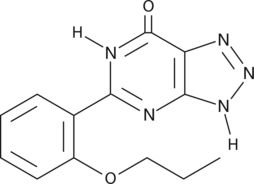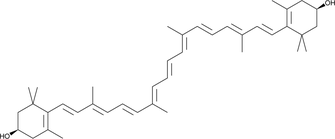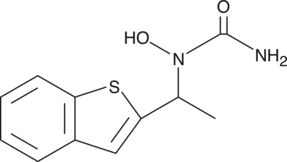Chemicals
Showing 40501–40650 of 41137 results
-
Z-VAD(OH)-FMK is an irreversible tripeptide inhibitor of all caspases.{23431,23430,7777} This non-methylated form is useful in studies involving recombinant, isolated, or purified enzymes. Unlike the methylated form, Z-VAD(OMe)-FMK (Item No. 14463), this compound does not require pretreatment with esterases prior to in vitro use.
Brand:CaymanSKU:-Z-VAD(OH)-FMK is an irreversible tripeptide inhibitor of all caspases.{23431,23430,7777} This non-methylated form is useful in studies involving recombinant, isolated, or purified enzymes. Unlike the methylated form, Z-VAD(OMe)-FMK (Item No. 14463), this compound does not require pretreatment with esterases prior to in vitro use.
Brand:CaymanSKU:-Z-VAD(OMe)-FMK is a cell-permeable, competitive, and irreversible inhibitor of all caspases.{22863,7777} Through this action, it inhibits cleavage of poly(ADP-ribose) polymerase, preventing apoptosis when used at 10-50 µM.{22863,22860} It also blocks caspase-mediated apoptosis in vivo.{22858} Z-VAD(OMe)-FMK effectively prevents caspase action in inflammasomes.{22859}
Brand:CaymanSKU:-Z-VAD(OMe)-FMK is a cell-permeable, competitive, and irreversible inhibitor of all caspases.{22863,7777} Through this action, it inhibits cleavage of poly(ADP-ribose) polymerase, preventing apoptosis when used at 10-50 µM.{22863,22860} It also blocks caspase-mediated apoptosis in vivo.{22858} Z-VAD(OMe)-FMK effectively prevents caspase action in inflammasomes.{22859}
Brand:CaymanSKU:-Z3-Dodecenyl E2-butenoate is a female sex pheromone produced by the sweet potato weevil, C. formicarius. It has been used to bait and trap male sweet potato weevils to manage population counts in agriculture fields with reduced use of insecticides.{32102}
Brand:CaymanSKU:19787 -Available on backorder
Z3-Dodecenyl E2-butenoate is a female sex pheromone produced by the sweet potato weevil, C. formicarius. It has been used to bait and trap male sweet potato weevils to manage population counts in agriculture fields with reduced use of insecticides.{32102}
Brand:CaymanSKU:19787 -Available on backorder
Z3-Dodecenyl E2-butenoate is a female sex pheromone produced by the sweet potato weevil, C. formicarius. It has been used to bait and trap male sweet potato weevils to manage population counts in agriculture fields with reduced use of insecticides.{32102}
Brand:CaymanSKU:19787 -Available on backorder
Z944 is an inhibitor of T-type calcium channels (IC50s = 0.050-0.160 µM for the human recombinant voltage-gated calcium (Cav) channels Cav3.1, Cav3.2, and Cav3.3).{52410} It is selective for T-type channels over the N-type Cav2.2 channel (IC50 = 11 µM), as well as the rat L-type Cav1.2, human-ether-a-go-go (hERG/Kv11.1) potassium, and human voltage-gated sodium (Nav) channel Nav1.5 (IC50s = 32, 7.8, and 100 µM, respectively). Z944 (30 mg/kg) reduces the seizure duration and the amount of time rats spend in seizures in a model of absence epilepsy. It delays seizure progression in amygdala-kindled rats but does not inhibit seizures in fully kindled rats.{52411}
Brand:CaymanSKU:27679 - 1 mgAvailable on backorder
Z944 is an inhibitor of T-type calcium channels (IC50s = 0.050-0.160 µM for the human recombinant voltage-gated calcium (Cav) channels Cav3.1, Cav3.2, and Cav3.3).{52410} It is selective for T-type channels over the N-type Cav2.2 channel (IC50 = 11 µM), as well as the rat L-type Cav1.2, human-ether-a-go-go (hERG/Kv11.1) potassium, and human voltage-gated sodium (Nav) channel Nav1.5 (IC50s = 32, 7.8, and 100 µM, respectively). Z944 (30 mg/kg) reduces the seizure duration and the amount of time rats spend in seizures in a model of absence epilepsy. It delays seizure progression in amygdala-kindled rats but does not inhibit seizures in fully kindled rats.{52411}
Brand:CaymanSKU:27679 - 10 mgAvailable on backorder
Z944 is an inhibitor of T-type calcium channels (IC50s = 0.050-0.160 µM for the human recombinant voltage-gated calcium (Cav) channels Cav3.1, Cav3.2, and Cav3.3).{52410} It is selective for T-type channels over the N-type Cav2.2 channel (IC50 = 11 µM), as well as the rat L-type Cav1.2, human-ether-a-go-go (hERG/Kv11.1) potassium, and human voltage-gated sodium (Nav) channel Nav1.5 (IC50s = 32, 7.8, and 100 µM, respectively). Z944 (30 mg/kg) reduces the seizure duration and the amount of time rats spend in seizures in a model of absence epilepsy. It delays seizure progression in amygdala-kindled rats but does not inhibit seizures in fully kindled rats.{52411}
Brand:CaymanSKU:27679 - 25 mgAvailable on backorder
Z944 is an inhibitor of T-type calcium channels (IC50s = 0.050-0.160 µM for the human recombinant voltage-gated calcium (Cav) channels Cav3.1, Cav3.2, and Cav3.3).{52410} It is selective for T-type channels over the N-type Cav2.2 channel (IC50 = 11 µM), as well as the rat L-type Cav1.2, human-ether-a-go-go (hERG/Kv11.1) potassium, and human voltage-gated sodium (Nav) channel Nav1.5 (IC50s = 32, 7.8, and 100 µM, respectively). Z944 (30 mg/kg) reduces the seizure duration and the amount of time rats spend in seizures in a model of absence epilepsy. It delays seizure progression in amygdala-kindled rats but does not inhibit seizures in fully kindled rats.{52411}
Brand:CaymanSKU:27679 - 5 mgAvailable on backorder
Zafirlukast is a cysteinyl leukotriene 1 (CysLT1) receptor antagonist (IC50 = 0.014 μM in a cell-based calcium mobilization assay).{49502} It is selective for CysLT1 over CysLT2 receptors (IC50 = 58 μM). It inhibits mucus secretion induced by leukotriene D4 (LTD4; Item No. 20310) in isolated guinea pig trachea (IC50 = 0.6 μM).{46532} Zafirlukast (5 μM) inhibits ovalbumin-induced increases in tracheal mucus secretion in ovalbumin-sensitized guinea pigs by 65%. It inhibits LTD4-induced bronchoconstriction in anesthetized guinea pigs (ED50 = 61 nmol/kg, i.v.).{10911} Formulations containing zafirlukast have been used in the prophylaxis and chronic treatment of asthma.
Brand:CaymanSKU:10008282 - 1 gAvailable on backorder
Zafirlukast is a cysteinyl leukotriene 1 (CysLT1) receptor antagonist (IC50 = 0.014 μM in a cell-based calcium mobilization assay).{49502} It is selective for CysLT1 over CysLT2 receptors (IC50 = 58 μM). It inhibits mucus secretion induced by leukotriene D4 (LTD4; Item No. 20310) in isolated guinea pig trachea (IC50 = 0.6 μM).{46532} Zafirlukast (5 μM) inhibits ovalbumin-induced increases in tracheal mucus secretion in ovalbumin-sensitized guinea pigs by 65%. It inhibits LTD4-induced bronchoconstriction in anesthetized guinea pigs (ED50 = 61 nmol/kg, i.v.).{10911} Formulations containing zafirlukast have been used in the prophylaxis and chronic treatment of asthma.
Brand:CaymanSKU:10008282 - 10 mgAvailable on backorder
Zafirlukast is a cysteinyl leukotriene 1 (CysLT1) receptor antagonist (IC50 = 0.014 μM in a cell-based calcium mobilization assay).{49502} It is selective for CysLT1 over CysLT2 receptors (IC50 = 58 μM). It inhibits mucus secretion induced by leukotriene D4 (LTD4; Item No. 20310) in isolated guinea pig trachea (IC50 = 0.6 μM).{46532} Zafirlukast (5 μM) inhibits ovalbumin-induced increases in tracheal mucus secretion in ovalbumin-sensitized guinea pigs by 65%. It inhibits LTD4-induced bronchoconstriction in anesthetized guinea pigs (ED50 = 61 nmol/kg, i.v.).{10911} Formulations containing zafirlukast have been used in the prophylaxis and chronic treatment of asthma.
Brand:CaymanSKU:10008282 - 100 mgAvailable on backorder
Zafirlukast is a cysteinyl leukotriene 1 (CysLT1) receptor antagonist (IC50 = 0.014 μM in a cell-based calcium mobilization assay).{49502} It is selective for CysLT1 over CysLT2 receptors (IC50 = 58 μM). It inhibits mucus secretion induced by leukotriene D4 (LTD4; Item No. 20310) in isolated guinea pig trachea (IC50 = 0.6 μM).{46532} Zafirlukast (5 μM) inhibits ovalbumin-induced increases in tracheal mucus secretion in ovalbumin-sensitized guinea pigs by 65%. It inhibits LTD4-induced bronchoconstriction in anesthetized guinea pigs (ED50 = 61 nmol/kg, i.v.).{10911} Formulations containing zafirlukast have been used in the prophylaxis and chronic treatment of asthma.
Brand:CaymanSKU:10008282 - 500 mgAvailable on backorder
Zalcitabine is an analog of pyrimidine derived from deoxycytidine with the replacement of the hydroxyl group in position 3’ with a hydrogen.{8362} In cells, it is phosphorylated to the active triphosphate form, ddCTP, which acts as a substrate for HIV reverse transcriptase (Ki = 51 nM).{26225,26224} It incorporates into viral DNA where it terminates chain elongation when the missing hydroxyl group is encountered. Zalcitabine was the third antiretroviral approved by the FDA for treatment of HIV infection and AIDS.{24196}
Brand:CaymanSKU:-Zalcitabine is an analog of pyrimidine derived from deoxycytidine with the replacement of the hydroxyl group in position 3’ with a hydrogen.{8362} In cells, it is phosphorylated to the active triphosphate form, ddCTP, which acts as a substrate for HIV reverse transcriptase (Ki = 51 nM).{26225,26224} It incorporates into viral DNA where it terminates chain elongation when the missing hydroxyl group is encountered. Zalcitabine was the third antiretroviral approved by the FDA for treatment of HIV infection and AIDS.{24196}
Brand:CaymanSKU:-Zalcitabine is an analog of pyrimidine derived from deoxycytidine with the replacement of the hydroxyl group in position 3’ with a hydrogen.{8362} In cells, it is phosphorylated to the active triphosphate form, ddCTP, which acts as a substrate for HIV reverse transcriptase (Ki = 51 nM).{26225,26224} It incorporates into viral DNA where it terminates chain elongation when the missing hydroxyl group is encountered. Zalcitabine was the third antiretroviral approved by the FDA for treatment of HIV infection and AIDS.{24196}
Brand:CaymanSKU:-Zalcitabine is an analog of pyrimidine derived from deoxycytidine with the replacement of the hydroxyl group in position 3’ with a hydrogen.{8362} In cells, it is phosphorylated to the active triphosphate form, ddCTP, which acts as a substrate for HIV reverse transcriptase (Ki = 51 nM).{26225,26224} It incorporates into viral DNA where it terminates chain elongation when the missing hydroxyl group is encountered. Zalcitabine was the third antiretroviral approved by the FDA for treatment of HIV infection and AIDS.{24196}
Brand:CaymanSKU:-Zaltoprofen is a cyclooxygenase (COX) inhibitor that displays slight preferential inhibition for COX-2 (IC50s = 1.3 and 0.34 μM for COX-1 and COX-2, respectively).{23288} Independent of COX inhibition, zaltoprofen has also been reported to inhibit bradykinin-induced nociceptive responses by blocking the activation of protein kinase C.{23287}
Brand:CaymanSKU:-Zaltoprofen is a cyclooxygenase (COX) inhibitor that displays slight preferential inhibition for COX-2 (IC50s = 1.3 and 0.34 μM for COX-1 and COX-2, respectively).{23288} Independent of COX inhibition, zaltoprofen has also been reported to inhibit bradykinin-induced nociceptive responses by blocking the activation of protein kinase C.{23287}
Brand:CaymanSKU:-Zaltoprofen is a cyclooxygenase (COX) inhibitor that displays slight preferential inhibition for COX-2 (IC50s = 1.3 and 0.34 μM for COX-1 and COX-2, respectively).{23288} Independent of COX inhibition, zaltoprofen has also been reported to inhibit bradykinin-induced nociceptive responses by blocking the activation of protein kinase C.{23287}
Brand:CaymanSKU:-Zaltoprofen is a cyclooxygenase (COX) inhibitor that displays slight preferential inhibition for COX-2 (IC50s = 1.3 and 0.34 μM for COX-1 and COX-2, respectively).{23288} Independent of COX inhibition, zaltoprofen has also been reported to inhibit bradykinin-induced nociceptive responses by blocking the activation of protein kinase C.{23287}
Brand:CaymanSKU:-Zanamivir is a sialic acid analog that inhibits neuraminidase release of newly replicated influenza virus particles.{24439} It has been shown to selectively inhibit the growth of influenza A and B viruses in plaque reduction assays with IC50 values ranging from 5 to 14 nM and to directly inhibit influenza A and B virus neuraminidases with IC50 values ranging from 0.6 to 7.9 nM in vitro.{24439} Intranasal zanamivir administration at 0.4 mg/kg twice daily can reduce mortality and viral titers in lung homogenates of mice infected with influenza.{24439}
Brand:CaymanSKU:-Zanamivir is a sialic acid analog that inhibits neuraminidase release of newly replicated influenza virus particles.{24439} It has been shown to selectively inhibit the growth of influenza A and B viruses in plaque reduction assays with IC50 values ranging from 5 to 14 nM and to directly inhibit influenza A and B virus neuraminidases with IC50 values ranging from 0.6 to 7.9 nM in vitro.{24439} Intranasal zanamivir administration at 0.4 mg/kg twice daily can reduce mortality and viral titers in lung homogenates of mice infected with influenza.{24439}
Brand:CaymanSKU:-Zanamivir is a sialic acid analog that inhibits neuraminidase release of newly replicated influenza virus particles.{24439} It has been shown to selectively inhibit the growth of influenza A and B viruses in plaque reduction assays with IC50 values ranging from 5 to 14 nM and to directly inhibit influenza A and B virus neuraminidases with IC50 values ranging from 0.6 to 7.9 nM in vitro.{24439} Intranasal zanamivir administration at 0.4 mg/kg twice daily can reduce mortality and viral titers in lung homogenates of mice infected with influenza.{24439}
Brand:CaymanSKU:-Zanamivir is a sialic acid analog that inhibits neuraminidase release of newly replicated influenza virus particles.{24439} It has been shown to selectively inhibit the growth of influenza A and B viruses in plaque reduction assays with IC50 values ranging from 5 to 14 nM and to directly inhibit influenza A and B virus neuraminidases with IC50 values ranging from 0.6 to 7.9 nM in vitro.{24439} Intranasal zanamivir administration at 0.4 mg/kg twice daily can reduce mortality and viral titers in lung homogenates of mice infected with influenza.{24439}
Brand:CaymanSKU:-Zanamivir-13C,15N2 is intended for use as an internal standard for the quantification of zanamivir (Item No. 15123) by GC- or LC-MS. Zanamivir is a sialic acid analog that inhibits neuraminidase release of newly replicated influenza virus particles.{24439} It has been shown to selectively inhibit the growth of influenza A and B viruses in plaque reduction assays with IC50 values ranging from 5 to 14 nM and to directly inhibit influenza A and B virus neuraminidases with IC50 values ranging from 0.6 to 7.9 nM in vitro. Intranasal zanamivir administration at 0.4 mg/kg twice daily reduces mortality and viral titers in lung homogenates of mice infected with influenza.
Brand:CaymanSKU:30733 - 250 µgAvailable on backorder
Zanubrutinib is a potent and covalent inhibitor of Bruton’s tyrosine kinase (BTK; IC50 = 0.3 nM).{52108} It is selective for BTK over a panel of 304 kinases at 1 μM but does inhibit EGFR, Tec, Blk, BMX, HER4, and TXK (IC50s = 0.62-33 nM). Zanubrutinib inhibits phosphorylation of BTK at Y233 (IC50 = 1.8 nM) in Ramos cells and reduces viability of REC-1 cells (IC50 = 0.36 nM). In vivo, zanubrutinib (2.5 and 7.5 mg/kg) reduces tumor volume in an OCI-LY10 diffuse large B cell lymphoma (DLBCL) mouse xenograft model.
Brand:CaymanSKU:28924 - 1 mgAvailable on backorder
Zanubrutinib is a potent and covalent inhibitor of Bruton’s tyrosine kinase (BTK; IC50 = 0.3 nM).{52108} It is selective for BTK over a panel of 304 kinases at 1 μM but does inhibit EGFR, Tec, Blk, BMX, HER4, and TXK (IC50s = 0.62-33 nM). Zanubrutinib inhibits phosphorylation of BTK at Y233 (IC50 = 1.8 nM) in Ramos cells and reduces viability of REC-1 cells (IC50 = 0.36 nM). In vivo, zanubrutinib (2.5 and 7.5 mg/kg) reduces tumor volume in an OCI-LY10 diffuse large B cell lymphoma (DLBCL) mouse xenograft model.
Brand:CaymanSKU:28924 - 10 mgAvailable on backorder
Zanubrutinib is a potent and covalent inhibitor of Bruton’s tyrosine kinase (BTK; IC50 = 0.3 nM).{52108} It is selective for BTK over a panel of 304 kinases at 1 μM but does inhibit EGFR, Tec, Blk, BMX, HER4, and TXK (IC50s = 0.62-33 nM). Zanubrutinib inhibits phosphorylation of BTK at Y233 (IC50 = 1.8 nM) in Ramos cells and reduces viability of REC-1 cells (IC50 = 0.36 nM). In vivo, zanubrutinib (2.5 and 7.5 mg/kg) reduces tumor volume in an OCI-LY10 diffuse large B cell lymphoma (DLBCL) mouse xenograft model.
Brand:CaymanSKU:28924 - 25 mgAvailable on backorder
Zanubrutinib is a potent and covalent inhibitor of Bruton’s tyrosine kinase (BTK; IC50 = 0.3 nM).{52108} It is selective for BTK over a panel of 304 kinases at 1 μM but does inhibit EGFR, Tec, Blk, BMX, HER4, and TXK (IC50s = 0.62-33 nM). Zanubrutinib inhibits phosphorylation of BTK at Y233 (IC50 = 1.8 nM) in Ramos cells and reduces viability of REC-1 cells (IC50 = 0.36 nM). In vivo, zanubrutinib (2.5 and 7.5 mg/kg) reduces tumor volume in an OCI-LY10 diffuse large B cell lymphoma (DLBCL) mouse xenograft model.
Brand:CaymanSKU:28924 - 5 mgAvailable on backorder
The cyclic nucleotide second messenger guanosine 3’5’-cyclic monophosphate (cGMP) is an important mediator of signal transduction and hence a wide range of cellular processes. It can be generated by soluble guanylyl cyclase in response to binding of nitric oxide and degraded via members of the phosphodiesterase (PDE) protein family. Zaprinast, the compound from which sildenafil (Viagra™) was developed, is a cGMP-specific phosphodiesterase inhibitor. It moderately inhibits PDE5 and PDE6 with IC50 values of 0.5-0.76 and 0.15 µM, respectively, and weakly inhibits PDE9, PDE10, and PDE11 with IC50 values of 35, 22, and 11-33 µM, respectively.{16348,16349} Zaprinast therefore enhances the vasodilatory effects of nitric oxide in a range of vascular tissues by prolonging the cGMP-mediated activation of cGMP-dependent protein kinase.{16349} Zaprinast also activates both the rat and human G protein-coupled receptor, GPR35 with EC50 values of 16 nM and 0.84 µM, respectively.{14754}
Brand:CaymanSKU:10010421 - 10 mgAvailable on backorder
The cyclic nucleotide second messenger guanosine 3’5’-cyclic monophosphate (cGMP) is an important mediator of signal transduction and hence a wide range of cellular processes. It can be generated by soluble guanylyl cyclase in response to binding of nitric oxide and degraded via members of the phosphodiesterase (PDE) protein family. Zaprinast, the compound from which sildenafil (Viagra™) was developed, is a cGMP-specific phosphodiesterase inhibitor. It moderately inhibits PDE5 and PDE6 with IC50 values of 0.5-0.76 and 0.15 µM, respectively, and weakly inhibits PDE9, PDE10, and PDE11 with IC50 values of 35, 22, and 11-33 µM, respectively.{16348,16349} Zaprinast therefore enhances the vasodilatory effects of nitric oxide in a range of vascular tissues by prolonging the cGMP-mediated activation of cGMP-dependent protein kinase.{16349} Zaprinast also activates both the rat and human G protein-coupled receptor, GPR35 with EC50 values of 16 nM and 0.84 µM, respectively.{14754}
Brand:CaymanSKU:10010421 - 100 mgAvailable on backorder
The cyclic nucleotide second messenger guanosine 3’5’-cyclic monophosphate (cGMP) is an important mediator of signal transduction and hence a wide range of cellular processes. It can be generated by soluble guanylyl cyclase in response to binding of nitric oxide and degraded via members of the phosphodiesterase (PDE) protein family. Zaprinast, the compound from which sildenafil (Viagra™) was developed, is a cGMP-specific phosphodiesterase inhibitor. It moderately inhibits PDE5 and PDE6 with IC50 values of 0.5-0.76 and 0.15 µM, respectively, and weakly inhibits PDE9, PDE10, and PDE11 with IC50 values of 35, 22, and 11-33 µM, respectively.{16348,16349} Zaprinast therefore enhances the vasodilatory effects of nitric oxide in a range of vascular tissues by prolonging the cGMP-mediated activation of cGMP-dependent protein kinase.{16349} Zaprinast also activates both the rat and human G protein-coupled receptor, GPR35 with EC50 values of 16 nM and 0.84 µM, respectively.{14754}
Brand:CaymanSKU:10010421 - 250 mgAvailable on backorder
The cyclic nucleotide second messenger guanosine 3’5’-cyclic monophosphate (cGMP) is an important mediator of signal transduction and hence a wide range of cellular processes. It can be generated by soluble guanylyl cyclase in response to binding of nitric oxide and degraded via members of the phosphodiesterase (PDE) protein family. Zaprinast, the compound from which sildenafil (Viagra™) was developed, is a cGMP-specific phosphodiesterase inhibitor. It moderately inhibits PDE5 and PDE6 with IC50 values of 0.5-0.76 and 0.15 µM, respectively, and weakly inhibits PDE9, PDE10, and PDE11 with IC50 values of 35, 22, and 11-33 µM, respectively.{16348,16349} Zaprinast therefore enhances the vasodilatory effects of nitric oxide in a range of vascular tissues by prolonging the cGMP-mediated activation of cGMP-dependent protein kinase.{16349} Zaprinast also activates both the rat and human G protein-coupled receptor, GPR35 with EC50 values of 16 nM and 0.84 µM, respectively.{14754}
Brand:CaymanSKU:10010421 - 50 mgAvailable on backorder
Squalene synthase catalyzes the first committed step in cholesterol synthesis, mediating the reductive dimerization of farnesyl pyrophosphate (Item No. 63250) to produce squalene.{15286} Zaragozic acid A is a fungal metabolite that acts as a reversible competitive inhibitor of squalene synthase (Ki = 78 pM in vitro).{28249} It dose-dependently reduces cholesterol synthesis in HepG2 cells (IC50 = 6 µM) and inhibits hepatic cholesterol synthesis in mice (ED50 = 0.2 mg/kg).{28249} Zaragozic acid A also inhibits farnesy transferase (FTase) and geranylgeranyl transferase type I (GGTase I) (IC50s = 216 and 50 nM, respectively).{1196}
Brand:CaymanSKU:-Available on backorder
Squalene synthase catalyzes the first committed step in cholesterol synthesis, mediating the reductive dimerization of farnesyl pyrophosphate (Item No. 63250) to produce squalene.{15286} Zaragozic acid A is a fungal metabolite that acts as a reversible competitive inhibitor of squalene synthase (Ki = 78 pM in vitro).{28249} It dose-dependently reduces cholesterol synthesis in HepG2 cells (IC50 = 6 µM) and inhibits hepatic cholesterol synthesis in mice (ED50 = 0.2 mg/kg).{28249} Zaragozic acid A also inhibits farnesy transferase (FTase) and geranylgeranyl transferase type I (GGTase I) (IC50s = 216 and 50 nM, respectively).{1196}
Brand:CaymanSKU:-Available on backorder
Zardaverine is a dual inhibitor of phosphodiesterase 3 (PDE3) and PDE4 (IC50s = 0.617 and 1.738 μM, respectively, for the rat cardiac ventricle enzymes).{46697} It is selective for PDE3 and PDE4 over PDE1B, PDE2, and PDE5 (IC50s = >138 μM for all). Zardaverine inhibits aggregation of human platelets induced by ADP (Item No. 21121), platelet-activating factor (PAF), collagen, arachidonic acid (Item Nos. 90010 | 90010.1 | 10006607), or prostaglandin E1 (PGE1; Item No. 13010) and ADP (IC50s = 1.5-16.2 μM). It inhibits zymosan-induced superoxide anion release from human polymorphonuclear (PMN) cells (IC50 = 0.4 μM). Zardaverine (10 μmol/kg) decreases lung resistance and increases dynamic compliance in a rat model of acetylcholine-induced bronchospasm.{46698} It decreases the viability of HeLa, COLO 741, NCI H2122, and A2058 cells that endogenously express high levels of PDE3A (IC50s = 0.032, 0.027, 0.26, and 0.13 μM, respectively), but is inactive against a panel of eight cancer cell lines that express low levels of PDE3A (IC50s = >16 μM for all).{46699}
Brand:CaymanSKU:29685 - 1 mgAvailable on backorder
Zardaverine is a dual inhibitor of phosphodiesterase 3 (PDE3) and PDE4 (IC50s = 0.617 and 1.738 μM, respectively, for the rat cardiac ventricle enzymes).{46697} It is selective for PDE3 and PDE4 over PDE1B, PDE2, and PDE5 (IC50s = >138 μM for all). Zardaverine inhibits aggregation of human platelets induced by ADP (Item No. 21121), platelet-activating factor (PAF), collagen, arachidonic acid (Item Nos. 90010 | 90010.1 | 10006607), or prostaglandin E1 (PGE1; Item No. 13010) and ADP (IC50s = 1.5-16.2 μM). It inhibits zymosan-induced superoxide anion release from human polymorphonuclear (PMN) cells (IC50 = 0.4 μM). Zardaverine (10 μmol/kg) decreases lung resistance and increases dynamic compliance in a rat model of acetylcholine-induced bronchospasm.{46698} It decreases the viability of HeLa, COLO 741, NCI H2122, and A2058 cells that endogenously express high levels of PDE3A (IC50s = 0.032, 0.027, 0.26, and 0.13 μM, respectively), but is inactive against a panel of eight cancer cell lines that express low levels of PDE3A (IC50s = >16 μM for all).{46699}
Brand:CaymanSKU:29685 - 10 mgAvailable on backorder
Zardaverine is a dual inhibitor of phosphodiesterase 3 (PDE3) and PDE4 (IC50s = 0.617 and 1.738 μM, respectively, for the rat cardiac ventricle enzymes).{46697} It is selective for PDE3 and PDE4 over PDE1B, PDE2, and PDE5 (IC50s = >138 μM for all). Zardaverine inhibits aggregation of human platelets induced by ADP (Item No. 21121), platelet-activating factor (PAF), collagen, arachidonic acid (Item Nos. 90010 | 90010.1 | 10006607), or prostaglandin E1 (PGE1; Item No. 13010) and ADP (IC50s = 1.5-16.2 μM). It inhibits zymosan-induced superoxide anion release from human polymorphonuclear (PMN) cells (IC50 = 0.4 μM). Zardaverine (10 μmol/kg) decreases lung resistance and increases dynamic compliance in a rat model of acetylcholine-induced bronchospasm.{46698} It decreases the viability of HeLa, COLO 741, NCI H2122, and A2058 cells that endogenously express high levels of PDE3A (IC50s = 0.032, 0.027, 0.26, and 0.13 μM, respectively), but is inactive against a panel of eight cancer cell lines that express low levels of PDE3A (IC50s = >16 μM for all).{46699}
Brand:CaymanSKU:29685 - 25 mgAvailable on backorder
Zardaverine is a dual inhibitor of phosphodiesterase 3 (PDE3) and PDE4 (IC50s = 0.617 and 1.738 μM, respectively, for the rat cardiac ventricle enzymes).{46697} It is selective for PDE3 and PDE4 over PDE1B, PDE2, and PDE5 (IC50s = >138 μM for all). Zardaverine inhibits aggregation of human platelets induced by ADP (Item No. 21121), platelet-activating factor (PAF), collagen, arachidonic acid (Item Nos. 90010 | 90010.1 | 10006607), or prostaglandin E1 (PGE1; Item No. 13010) and ADP (IC50s = 1.5-16.2 μM). It inhibits zymosan-induced superoxide anion release from human polymorphonuclear (PMN) cells (IC50 = 0.4 μM). Zardaverine (10 μmol/kg) decreases lung resistance and increases dynamic compliance in a rat model of acetylcholine-induced bronchospasm.{46698} It decreases the viability of HeLa, COLO 741, NCI H2122, and A2058 cells that endogenously express high levels of PDE3A (IC50s = 0.032, 0.027, 0.26, and 0.13 μM, respectively), but is inactive against a panel of eight cancer cell lines that express low levels of PDE3A (IC50s = >16 μM for all).{46699}
Brand:CaymanSKU:29685 - 5 mgAvailable on backorder
Zatebradine is a bradycardic compound that blocks hyperpolarization-activated inward current (If) through cyclic nucleotide-gated cation (HCN) channels in sinoatrial node cells (IC50s = 1.83, 2.21, 1.9, and 1.88 µM, respectively for HCN1-4 in vitro).{30118,25789} Additionally, it can block voltage-gated outward K+ (IK) currents and related neuronal hyperpolarization-activated inward current (Ih) channels, but exhibits little or no activity for L-type Ca2+ (ICa) currents.{30117,28049} When assessed through telemetric ECG recording in mice, zatebradine reduced heart rate from 600 to 200 beats per minute with an ED50 value of 1.8 mg/kg and induced increasing arrhythmia at concentrations >10 mg/kg.{30118}
Brand:CaymanSKU:-Available on backorder
Zatebradine is a bradycardic compound that blocks hyperpolarization-activated inward current (If) through cyclic nucleotide-gated cation (HCN) channels in sinoatrial node cells (IC50s = 1.83, 2.21, 1.9, and 1.88 µM, respectively for HCN1-4 in vitro).{30118,25789} Additionally, it can block voltage-gated outward K+ (IK) currents and related neuronal hyperpolarization-activated inward current (Ih) channels, but exhibits little or no activity for L-type Ca2+ (ICa) currents.{30117,28049} When assessed through telemetric ECG recording in mice, zatebradine reduced heart rate from 600 to 200 beats per minute with an ED50 value of 1.8 mg/kg and induced increasing arrhythmia at concentrations >10 mg/kg.{30118}
Brand:CaymanSKU:-Available on backorder
Zatebradine is a bradycardic compound that blocks hyperpolarization-activated inward current (If) through cyclic nucleotide-gated cation (HCN) channels in sinoatrial node cells (IC50s = 1.83, 2.21, 1.9, and 1.88 µM, respectively for HCN1-4 in vitro).{30118,25789} Additionally, it can block voltage-gated outward K+ (IK) currents and related neuronal hyperpolarization-activated inward current (Ih) channels, but exhibits little or no activity for L-type Ca2+ (ICa) currents.{30117,28049} When assessed through telemetric ECG recording in mice, zatebradine reduced heart rate from 600 to 200 beats per minute with an ED50 value of 1.8 mg/kg and induced increasing arrhythmia at concentrations >10 mg/kg.{30118}
Brand:CaymanSKU:-Available on backorder
Zatebradine is a bradycardic compound that blocks hyperpolarization-activated inward current (If) through cyclic nucleotide-gated cation (HCN) channels in sinoatrial node cells (IC50s = 1.83, 2.21, 1.9, and 1.88 µM, respectively for HCN1-4 in vitro).{30118,25789} Additionally, it can block voltage-gated outward K+ (IK) currents and related neuronal hyperpolarization-activated inward current (Ih) channels, but exhibits little or no activity for L-type Ca2+ (ICa) currents.{30117,28049} When assessed through telemetric ECG recording in mice, zatebradine reduced heart rate from 600 to 200 beats per minute with an ED50 value of 1.8 mg/kg and induced increasing arrhythmia at concentrations >10 mg/kg.{30118}
Brand:CaymanSKU:-Available on backorder
ZCL 278 is a cell-permeable inhibitor of Cdc42, a Rho family GTPase.{32673} It binds into the surface groove on Cdc42 (Kd = 6.4-11.4 µM), blocking interaction with intersectin (ITSN), a guanine nucleotide exchange factor (GEF).{32673} It inhibits Cdc42-mediated microspike formation and neuronal branching in 3T3 fibroblast and neonatal cortical neurons, respectively.{32673} ZCL 278 also exhibits potent antiviral activity by inhibiting cellular entry of Junin virus (JUNV) and other enveloped viruses into cells and inhibiting viral replication in mice.{32672}
Brand:CaymanSKU:-ZCL 278 is a cell-permeable inhibitor of Cdc42, a Rho family GTPase.{32673} It binds into the surface groove on Cdc42 (Kd = 6.4-11.4 µM), blocking interaction with intersectin (ITSN), a guanine nucleotide exchange factor (GEF).{32673} It inhibits Cdc42-mediated microspike formation and neuronal branching in 3T3 fibroblast and neonatal cortical neurons, respectively.{32673} ZCL 278 also exhibits potent antiviral activity by inhibiting cellular entry of Junin virus (JUNV) and other enveloped viruses into cells and inhibiting viral replication in mice.{32672}
Brand:CaymanSKU:-ZCL 278 is a cell-permeable inhibitor of Cdc42, a Rho family GTPase.{32673} It binds into the surface groove on Cdc42 (Kd = 6.4-11.4 µM), blocking interaction with intersectin (ITSN), a guanine nucleotide exchange factor (GEF).{32673} It inhibits Cdc42-mediated microspike formation and neuronal branching in 3T3 fibroblast and neonatal cortical neurons, respectively.{32673} ZCL 278 also exhibits potent antiviral activity by inhibiting cellular entry of Junin virus (JUNV) and other enveloped viruses into cells and inhibiting viral replication in mice.{32672}
Brand:CaymanSKU:-ZCL 278 is a cell-permeable inhibitor of Cdc42, a Rho family GTPase.{32673} It binds into the surface groove on Cdc42 (Kd = 6.4-11.4 µM), blocking interaction with intersectin (ITSN), a guanine nucleotide exchange factor (GEF).{32673} It inhibits Cdc42-mediated microspike formation and neuronal branching in 3T3 fibroblast and neonatal cortical neurons, respectively.{32673} ZCL 278 also exhibits potent antiviral activity by inhibiting cellular entry of Junin virus (JUNV) and other enveloped viruses into cells and inhibiting viral replication in mice.{32672}
Brand:CaymanSKU:-Potassium/sodium hyperpolarization-activated cyclic nucleotide-gated (HCN) channels contribute to native pacemaker currents in heart and neurons and modulate cardiac and neuronal excitability.{28047} Certain HCN channels also accentuate neuropathic pain.{28043} ZD 7288 is a potent blocker of HCN channels that inhibits HCN4 more potently than HCN1 (IC50s = 32 and 158 nM, respectively).{28045} Through its effects on HCN channels, ZD 7288 modulates the sinoatrial node and slows heart rate.{28049,28044} In addition, ZD 7288 reduces neuropathic pain in several animal models.{28046,28048}
Brand:CaymanSKU:-Potassium/sodium hyperpolarization-activated cyclic nucleotide-gated (HCN) channels contribute to native pacemaker currents in heart and neurons and modulate cardiac and neuronal excitability.{28047} Certain HCN channels also accentuate neuropathic pain.{28043} ZD 7288 is a potent blocker of HCN channels that inhibits HCN4 more potently than HCN1 (IC50s = 32 and 158 nM, respectively).{28045} Through its effects on HCN channels, ZD 7288 modulates the sinoatrial node and slows heart rate.{28049,28044} In addition, ZD 7288 reduces neuropathic pain in several animal models.{28046,28048}
Brand:CaymanSKU:-Potassium/sodium hyperpolarization-activated cyclic nucleotide-gated (HCN) channels contribute to native pacemaker currents in heart and neurons and modulate cardiac and neuronal excitability.{28047} Certain HCN channels also accentuate neuropathic pain.{28043} ZD 7288 is a potent blocker of HCN channels that inhibits HCN4 more potently than HCN1 (IC50s = 32 and 158 nM, respectively).{28045} Through its effects on HCN channels, ZD 7288 modulates the sinoatrial node and slows heart rate.{28049,28044} In addition, ZD 7288 reduces neuropathic pain in several animal models.{28046,28048}
Brand:CaymanSKU:-Potassium/sodium hyperpolarization-activated cyclic nucleotide-gated (HCN) channels contribute to native pacemaker currents in heart and neurons and modulate cardiac and neuronal excitability.{28047} Certain HCN channels also accentuate neuropathic pain.{28043} ZD 7288 is a potent blocker of HCN channels that inhibits HCN4 more potently than HCN1 (IC50s = 32 and 158 nM, respectively).{28045} Through its effects on HCN channels, ZD 7288 modulates the sinoatrial node and slows heart rate.{28049,28044} In addition, ZD 7288 reduces neuropathic pain in several animal models.{28046,28048}
Brand:CaymanSKU:-Zearalanone is a major phase I metabolite of the mycotoxin α-zearalanol (zeranol), a non-steroidal estrogen produced by fungi.{31431,31433} Zearalanone is an estrogen receptor agonist (EC50 = 0.11 µM).{31432} It also acts as an androgen receptor antagonist.{31434} Zearalanone, zearalenone (Item No. 11353), and related compounds can be abundant in plant material infected with Fusarium.{31430}
Brand:CaymanSKU:-Available on backorder
Zearalanone is a major phase I metabolite of the mycotoxin α-zearalanol (zeranol), a non-steroidal estrogen produced by fungi.{31431,31433} Zearalanone is an estrogen receptor agonist (EC50 = 0.11 µM).{31432} It also acts as an androgen receptor antagonist.{31434} Zearalanone, zearalenone (Item No. 11353), and related compounds can be abundant in plant material infected with Fusarium.{31430}
Brand:CaymanSKU:-Available on backorder
Zearalenone is a mycotoxin that has been found in Fusarium and has estrogenic activities.{20562} It binds to human estrogen receptor α (ERα) and ERβ (IC50s = 9 and 5.8 nM, respectively).{54526} Zearalenone induces precocious development of mammary tissues in young female pigs and prepucial enlargement in young male pigs.{20560} Zearalenone (1.5-5 mg/kg of diet) induces hyperestrogenism in pigs. It also induces degeneration of meiotic chromatin in oocytes and reduces fertility in pigs when administered at a dose of 200 µg/kg.{20561} Zearalenone has been found as a contaminant in wheat, maize, and barley and livestock feeds.{20560,20561}
Brand:CaymanSKU:11353 - 10 mgAvailable on backorder
Zearalenone is a mycotoxin that has been found in Fusarium and has estrogenic activities.{20562} It binds to human estrogen receptor α (ERα) and ERβ (IC50s = 9 and 5.8 nM, respectively).{54526} Zearalenone induces precocious development of mammary tissues in young female pigs and prepucial enlargement in young male pigs.{20560} Zearalenone (1.5-5 mg/kg of diet) induces hyperestrogenism in pigs. It also induces degeneration of meiotic chromatin in oocytes and reduces fertility in pigs when administered at a dose of 200 µg/kg.{20561} Zearalenone has been found as a contaminant in wheat, maize, and barley and livestock feeds.{20560,20561}
Brand:CaymanSKU:11353 - 25 mgAvailable on backorder
Zearalenone is a mycotoxin that has been found in Fusarium and has estrogenic activities.{20562} It binds to human estrogen receptor α (ERα) and ERβ (IC50s = 9 and 5.8 nM, respectively).{54526} Zearalenone induces precocious development of mammary tissues in young female pigs and prepucial enlargement in young male pigs.{20560} Zearalenone (1.5-5 mg/kg of diet) induces hyperestrogenism in pigs. It also induces degeneration of meiotic chromatin in oocytes and reduces fertility in pigs when administered at a dose of 200 µg/kg.{20561} Zearalenone has been found as a contaminant in wheat, maize, and barley and livestock feeds.{20560,20561}
Brand:CaymanSKU:11353 - 5 mgAvailable on backorder
Zearalenone-13C18 is intended for use as an internal standard for the quantification of zearalenone (Item No. 11353) by GC- or LC-MS. Zearalenone is a mycotoxin that has been found in Fusarium and has estrogenic activities.{20562} It binds to human estrogen receptor α (ERα) and ERβ (IC50s = 9 and 5.8 nM, respectively).{54526} Zearalenone induces precocious development of mammary tissues in young female pigs and prepucial enlargement in young male pigs.{20560} Zearalenone (1.5-5 mg/kg of diet) induces hyperestrogenism in pigs. It also induces degeneration of meiotic chromatin in oocytes and reduces fertility in pigs when administered at a dose of 200 µg/kg.{20561} Zearalenone has been found as a contaminant in wheat, maize, and barley and livestock feeds.{20560,20561}
Brand:CaymanSKU:31288 - 1.2 mlAvailable on backorder
Zeaxanthin is a dietary carotenoid that has been found in orange and yellow fruits and has diverse biological activities.{57132,57131,57130,16577,16578} In vivo, zeaxanthin (50 mg/kg) decreases immobility time in the forced swim test and reduces hippocampal levels of IL-6, IL-1β, and TNF-α in a rat model of diabetes induced by streptozotocin (STZ; Item No. 13104).{57132} It also reduces albuminuria, serum levels of urea nitrogen and malondialdehyde (MDA), and kidney damage in a rat model of STZ-induced diabetic nephropathy.{57131} It forms the macular pigment in human eyes, and high dietary intake of zeaxanthin is positively correlated with reduced risk of advanced neovascular age-related macular degeneration in humans.{57130,16577,16578}
Brand:CaymanSKU:10009992 - 1 mgAvailable on backorder
Zeaxanthin is a dietary carotenoid that has been found in orange and yellow fruits and has diverse biological activities.{57132,57131,57130,16577,16578} In vivo, zeaxanthin (50 mg/kg) decreases immobility time in the forced swim test and reduces hippocampal levels of IL-6, IL-1β, and TNF-α in a rat model of diabetes induced by streptozotocin (STZ; Item No. 13104).{57132} It also reduces albuminuria, serum levels of urea nitrogen and malondialdehyde (MDA), and kidney damage in a rat model of STZ-induced diabetic nephropathy.{57131} It forms the macular pigment in human eyes, and high dietary intake of zeaxanthin is positively correlated with reduced risk of advanced neovascular age-related macular degeneration in humans.{57130,16577,16578}
Brand:CaymanSKU:10009992 - 500 µgAvailable on backorder
Zeaxanthin dipalmitate is a carotenoid that has been found in F. lycii and has hepatoprotective activity.{59530,59531,59532,59533} It inhibits TGF-β-induced activation of hepatic stellate cells (IC50 = 186.34 µM).{59531} Zeaxanthin (25 mg/kg) reduces hepatic collagen deposition and levels of thiobarbituric acid reactive substances (TBARS), as well as the activity of serum aspartate aminotransferase (AST) and alkaline phosphatase (ALP), in a rat model of hepatic fibrosis induced by bile duct ligation.{59532} It also decreases reactivated levels of hepatitis B virus (HBV) DNA and reduces hepatic steatosis, inflammation, and fibrosis in a model of non-alcoholic steatohepatitis (NASH) induced by a methionine- and choline-deficient diet in HBV transgenic mice.{59533}
Brand:CaymanSKU:31703 - 1 mgAvailable on backorder
Zeaxanthin dipalmitate is a carotenoid that has been found in F. lycii and has hepatoprotective activity.{59530,59531,59532,59533} It inhibits TGF-β-induced activation of hepatic stellate cells (IC50 = 186.34 µM).{59531} Zeaxanthin (25 mg/kg) reduces hepatic collagen deposition and levels of thiobarbituric acid reactive substances (TBARS), as well as the activity of serum aspartate aminotransferase (AST) and alkaline phosphatase (ALP), in a rat model of hepatic fibrosis induced by bile duct ligation.{59532} It also decreases reactivated levels of hepatitis B virus (HBV) DNA and reduces hepatic steatosis, inflammation, and fibrosis in a model of non-alcoholic steatohepatitis (NASH) induced by a methionine- and choline-deficient diet in HBV transgenic mice.{59533}
Brand:CaymanSKU:31703 - 10 mgAvailable on backorder
Zeaxanthin dipalmitate is a carotenoid that has been found in F. lycii and has hepatoprotective activity.{59530,59531,59532,59533} It inhibits TGF-β-induced activation of hepatic stellate cells (IC50 = 186.34 µM).{59531} Zeaxanthin (25 mg/kg) reduces hepatic collagen deposition and levels of thiobarbituric acid reactive substances (TBARS), as well as the activity of serum aspartate aminotransferase (AST) and alkaline phosphatase (ALP), in a rat model of hepatic fibrosis induced by bile duct ligation.{59532} It also decreases reactivated levels of hepatitis B virus (HBV) DNA and reduces hepatic steatosis, inflammation, and fibrosis in a model of non-alcoholic steatohepatitis (NASH) induced by a methionine- and choline-deficient diet in HBV transgenic mice.{59533}
Brand:CaymanSKU:31703 - 5 mgAvailable on backorder
Zelkovamycin is a cyclic peptide antibiotic originally isolated from Streptomyces.{47418} It inhibits growth of X. oryzae, P. oryzae, S. aureus, and A. laidlawii in a concentration-dependent manner when used at concentrations ranging from 0.01 to 300 μg/ml.
Brand:CaymanSKU:27753 - 1 mgAvailable on backorder
Zelkovamycin is a cyclic peptide antibiotic originally isolated from Streptomyces.{47418} It inhibits growth of X. oryzae, P. oryzae, S. aureus, and A. laidlawii in a concentration-dependent manner when used at concentrations ranging from 0.01 to 300 μg/ml.
Brand:CaymanSKU:27753 - 5 mgAvailable on backorder
Zelkovamycin is a cyclic peptide antibiotic originally isolated from Streptomyces.{47418} It inhibits growth of X. oryzae, P. oryzae, S. aureus, and A. laidlawii in a concentration-dependent manner when used at concentrations ranging from 0.01 to 300 μg/ml.
Brand:CaymanSKU:27753 - 500 µgAvailable on backorder
Zerumbone is a natural monocyclic sesquiterpene first isolated from rhizomes of the wild ginger Z. zerumbet.{24909} It potently inhibits the activation of Epstein-Barr virus by phorbol esters (IC50 = 140 nM).{24909,24908} Zerumbone inhibits Sonic hedgehog signaling and induces apoptosis in cancer cell lines.{22122,24911,24910} It has also been shown to have anti-oxidant and anti-inflammatory activities, contributing to immunomodulatory and hepatoprotective effects.{24912}
Brand:CaymanSKU:-Zerumbone is a natural monocyclic sesquiterpene first isolated from rhizomes of the wild ginger Z. zerumbet.{24909} It potently inhibits the activation of Epstein-Barr virus by phorbol esters (IC50 = 140 nM).{24909,24908} Zerumbone inhibits Sonic hedgehog signaling and induces apoptosis in cancer cell lines.{22122,24911,24910} It has also been shown to have anti-oxidant and anti-inflammatory activities, contributing to immunomodulatory and hepatoprotective effects.{24912}
Brand:CaymanSKU:-Zerumbone is a natural monocyclic sesquiterpene first isolated from rhizomes of the wild ginger Z. zerumbet.{24909} It potently inhibits the activation of Epstein-Barr virus by phorbol esters (IC50 = 140 nM).{24909,24908} Zerumbone inhibits Sonic hedgehog signaling and induces apoptosis in cancer cell lines.{22122,24911,24910} It has also been shown to have anti-oxidant and anti-inflammatory activities, contributing to immunomodulatory and hepatoprotective effects.{24912}
Brand:CaymanSKU:-Zibotentan is a selective antagonist of the endothelin (ET) receptor type A (IC50s = 21 and >10,000 nM for human recombinant ETA and ETB, respectively).{40680} It inhibits growth of HEY, OVCA 433, SKOV3, and A2780 cells induced by endothelin 1 (ET-1; Item No. 24127) in vitro.{40681} Zibotentan reduces ET-1-induced expression of MMP-2, MMP-9, VEGF, COX-1 and COX-2, mediators of cell invasion and angiogenesis, in HEY cells. In vivo, zibotentan (10-50 mg/kg per day) reduces tumor growth in an HEY mouse xenograft model in a dose-dependent manner. Formulations containing zibotentan are under clinical investigation for the treatment of ovarian and castration-resistant prostate cancers.
Brand:CaymanSKU:23702 - 1 mgAvailable on backorder
Zibotentan is a selective antagonist of the endothelin (ET) receptor type A (IC50s = 21 and >10,000 nM for human recombinant ETA and ETB, respectively).{40680} It inhibits growth of HEY, OVCA 433, SKOV3, and A2780 cells induced by endothelin 1 (ET-1; Item No. 24127) in vitro.{40681} Zibotentan reduces ET-1-induced expression of MMP-2, MMP-9, VEGF, COX-1 and COX-2, mediators of cell invasion and angiogenesis, in HEY cells. In vivo, zibotentan (10-50 mg/kg per day) reduces tumor growth in an HEY mouse xenograft model in a dose-dependent manner. Formulations containing zibotentan are under clinical investigation for the treatment of ovarian and castration-resistant prostate cancers.
Brand:CaymanSKU:23702 - 10 mgAvailable on backorder
Zibotentan is a selective antagonist of the endothelin (ET) receptor type A (IC50s = 21 and >10,000 nM for human recombinant ETA and ETB, respectively).{40680} It inhibits growth of HEY, OVCA 433, SKOV3, and A2780 cells induced by endothelin 1 (ET-1; Item No. 24127) in vitro.{40681} Zibotentan reduces ET-1-induced expression of MMP-2, MMP-9, VEGF, COX-1 and COX-2, mediators of cell invasion and angiogenesis, in HEY cells. In vivo, zibotentan (10-50 mg/kg per day) reduces tumor growth in an HEY mouse xenograft model in a dose-dependent manner. Formulations containing zibotentan are under clinical investigation for the treatment of ovarian and castration-resistant prostate cancers.
Brand:CaymanSKU:23702 - 25 mgAvailable on backorder
Zibotentan is a selective antagonist of the endothelin (ET) receptor type A (IC50s = 21 and >10,000 nM for human recombinant ETA and ETB, respectively).{40680} It inhibits growth of HEY, OVCA 433, SKOV3, and A2780 cells induced by endothelin 1 (ET-1; Item No. 24127) in vitro.{40681} Zibotentan reduces ET-1-induced expression of MMP-2, MMP-9, VEGF, COX-1 and COX-2, mediators of cell invasion and angiogenesis, in HEY cells. In vivo, zibotentan (10-50 mg/kg per day) reduces tumor growth in an HEY mouse xenograft model in a dose-dependent manner. Formulations containing zibotentan are under clinical investigation for the treatment of ovarian and castration-resistant prostate cancers.
Brand:CaymanSKU:23702 - 5 mgAvailable on backorder
Zidovudine is a nucleoside reverse transcriptase inhibitor that, following triphosphorylation by thymidine kinase, potently blocks replication of HIV (EC50 = 3 nM) with low cytotoxicity (CC50 > 5 μM).{25338,25340,25341,25339} It is commonly used in combination therapy to slow the replication of HIV in vivo.{25337}
Brand:CaymanSKU:-Zidovudine is a nucleoside reverse transcriptase inhibitor that, following triphosphorylation by thymidine kinase, potently blocks replication of HIV (EC50 = 3 nM) with low cytotoxicity (CC50 > 5 μM).{25338,25340,25341,25339} It is commonly used in combination therapy to slow the replication of HIV in vivo.{25337}
Brand:CaymanSKU:-Zidovudine is a nucleoside reverse transcriptase inhibitor that, following triphosphorylation by thymidine kinase, potently blocks replication of HIV (EC50 = 3 nM) with low cytotoxicity (CC50 > 5 μM).{25338,25340,25341,25339} It is commonly used in combination therapy to slow the replication of HIV in vivo.{25337}
Brand:CaymanSKU:-Zidovudine is a nucleoside reverse transcriptase inhibitor that, following triphosphorylation by thymidine kinase, potently blocks replication of HIV (EC50 = 3 nM) with low cytotoxicity (CC50 > 5 μM).{25338,25340,25341,25339} It is commonly used in combination therapy to slow the replication of HIV in vivo.{25337}
Brand:CaymanSKU:-Zileuton is a reversible 5-lipoxygenase (5-LO) inhibitor.{1367} It inhibits 5-LO activity in rat basophilic leukemia-1 (RBL-1) cell supernatant with an IC50 value of 0.5 µM. Zileuton inhibits leukotriene B4 (LTB4; Item No. 20110) production induced by the calcium ionophore A23187 (Item No. 11016) in purified human peripheral blood polymorphonuclear leukocytes (PMNLs; IC50 = 0.6 µM). Zileuton (10 mg/kg, p.o.) prevents antigen challenge-induced increases in specific lung resistance in a sheep model of asthma at 4 to 8 hours post-challenge following administration 2 hours pre-challenge.{42699} Formulations containing zileuton have been used in the prophylaxis and chronic treatment of asthma.
Brand:CaymanSKU:10006967 - 10 mgAvailable on backorder
Zileuton is a reversible 5-lipoxygenase (5-LO) inhibitor.{1367} It inhibits 5-LO activity in rat basophilic leukemia-1 (RBL-1) cell supernatant with an IC50 value of 0.5 µM. Zileuton inhibits leukotriene B4 (LTB4; Item No. 20110) production induced by the calcium ionophore A23187 (Item No. 11016) in purified human peripheral blood polymorphonuclear leukocytes (PMNLs; IC50 = 0.6 µM). Zileuton (10 mg/kg, p.o.) prevents antigen challenge-induced increases in specific lung resistance in a sheep model of asthma at 4 to 8 hours post-challenge following administration 2 hours pre-challenge.{42699} Formulations containing zileuton have been used in the prophylaxis and chronic treatment of asthma.
Brand:CaymanSKU:10006967 - 25 mgAvailable on backorder

























